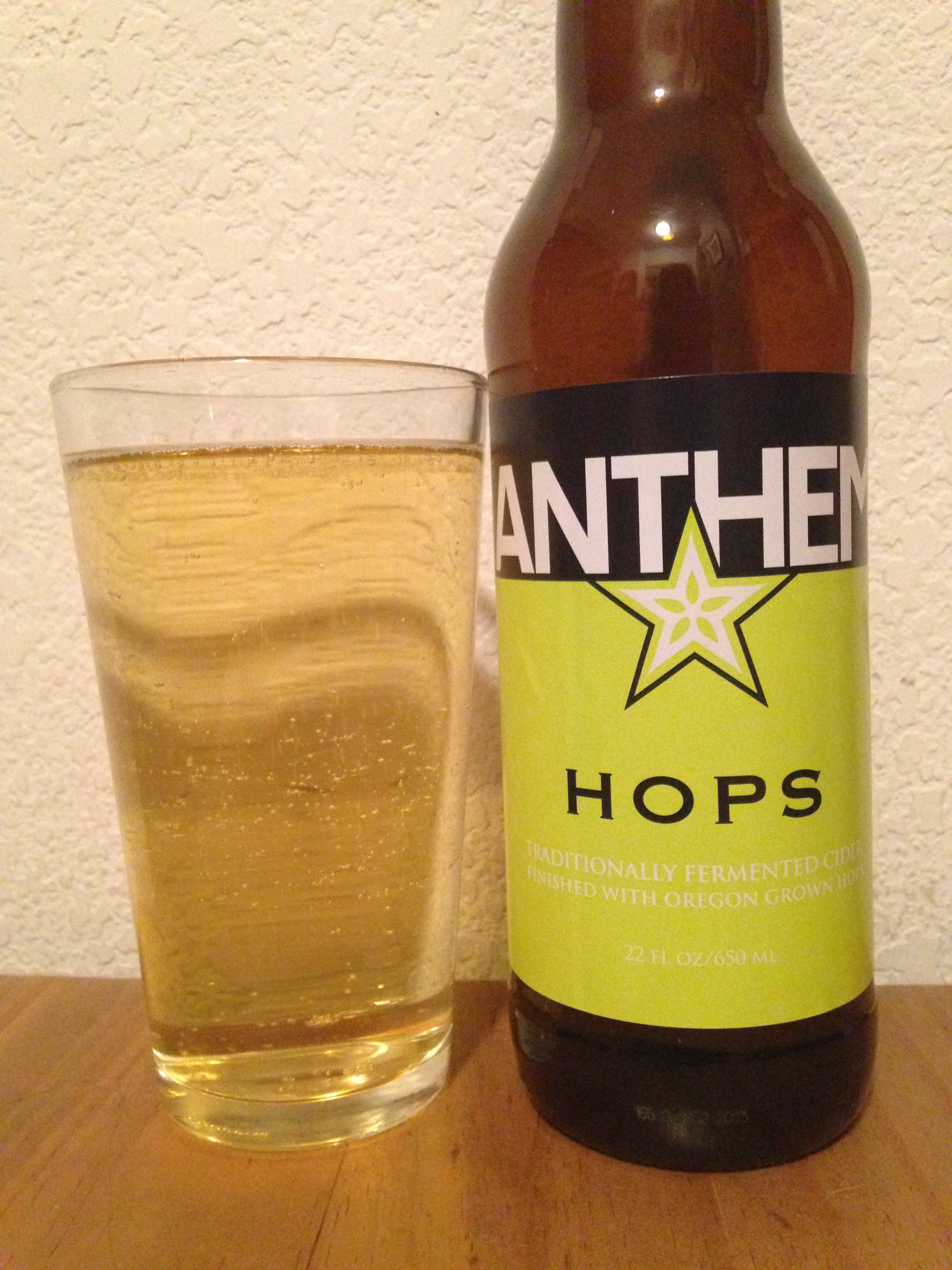Hard Cider Review: Anthem Hops

I obtained a bottle of Anthem Hops from a friend of mine, Joe, who lives in California, which unsurprisingly has better availability of Pacific Northwest ciders than I have here in Colorado. Perhaps that dynamic will change someday (FYI, if you’re a CO distributor reading and reading this, the above was a hint for you).
Now, on to the meat of the matter, and to the thorny issue of hopping a cider. Now, the American craft beer-obsessed among you–a group I fancy myself a part of–may be wondering…why wouldn’t you add hops to cider? Hell, why wouldn’t you add hops to any fermented alcoholic beverage? Fair enough…hops and lots of it has a well-earned place in the craft beverage world. But as with so many important things in life, the reality is complicated…
First, the product–Anthem Hops is a division of Wandering Aengus Ciderworks of Salem, Oregon, who are known as innovators in sourcing and growing multiple varieties of apples in the Pacific Northwest and making a multitude of ciders from them. While Wandering Aengus ciders include heirloom cider apples, the Anthem series is specifically designed to utilize the many dessert/table apples available in the Pacific Northwest.
All Anthem ciders start with a base blend of dessert apples which are actually disclosed on the label (this is a refreshing change from most Pacific Northwest ciders, who talk up their artisan cred but deliberately omit the actual blend content because they don’t want you to know it doesn’t include cider apples): Pink Lady, Granny Smith, and Golden Delicious.
This results in a cider base that you’ll be pretty familiar with if you’ve made your own cider from dessert/table apples or from store or farmstand-bought unfermented ciders–tart, slightly fruity, and thin. To this base Anthem adds either: 1) nothing, as is the case in their traditional Anthem cider; 2) pears, to Anthem Pear; 3) cherries, to Anthem Cherry; or 4) hops, to Anthem Hops.
Anthem Hops is very hop-dominant, dry-hopped as it is with another great Pacific Northwest product: Cascade hops. Problem is, it’s a bit too hop-dominant. The cider portion is nicely dry and tart, but it simply can’t stand up to the large amount of Cascade hops, with its intense, signature citrus and flowery aspects. The Cascade doesn’t add much bitterness, due to its own characteristics and the fact only dry-hopping is involved (which adds primarily aroma rather than the bitter flavor characteristics imparted by hops boiled with beer wort), but it’s still quite a bit too much, making Anthem hops seem like more of an alcoholic hop tea with hints of apple than a hard apple cider.
That hops was originally added to beer as an acidity-boosting preservative is instructive here as well–unlike barley malt, fruit, and particularly the Granny Smiths in this blend, already contains relatively high acidity. Adding hop alpha acids only intensifies this aspect, while the other hop characteristics drown out the delicate flavor that remains when fermenting dessert apples.
I’m not completely opposed to the concept of hopping cider, though, and this offering from Anthem–and especially the goal of making good cider from less-then-perfect-for-cider apples–is intriguing and unique enough that I’ll definitely check out their other products. On the commercial side, I’d like to see a more robust, made-with-bitter-apples cider base combined with less-aggressive hopping, rather than a ‘use additives to substitute for missing flavors in thin, dessert apple cider’ approach that I’ve seen more than once from commercial cider makers. To be fair, though, I admit I’ve certainly found the latter approach to be interesting–and sometimes quite necessary–in home cider-making.
For more information on cider apple varieties, cider blending, and cider acidity, I recommend Cider: Making, Using, and Enjoying Sweet and Hard Cider. For more general wine-making process–since cider-making is more like wine-making than brewing–see here.
–
Thanks for visiting The Cidersage Blog. If you found this content to be useful, consider subscribing via the Subscribe link in the side bar, and be sure to visit our resources and tutorials pages for more in-depth hard cider and mead information.
Leave a comment